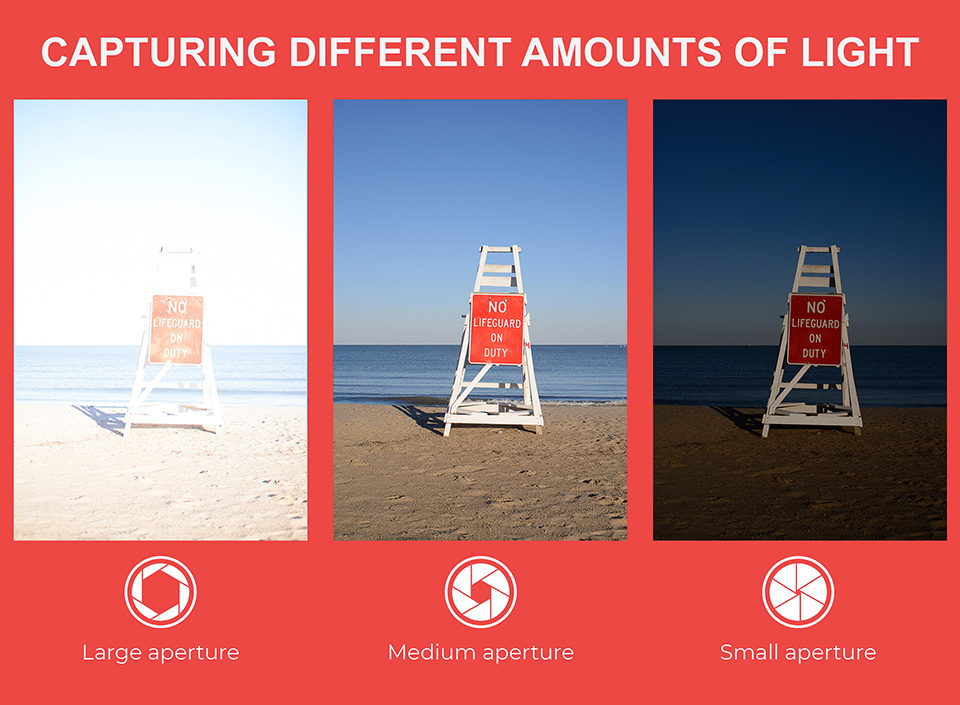Controls how long your camera's sensor is exposed to the light and is responsible for the motion appearance within photos. "An easy way to understand shutter speed is to liken it to your eyelids. For example, if you shut your eyes, then open them for 1/2 second without blinking, then shut them again, you've essentially created a 1/2 second exposure for your eyes. That is, for that 1/2 second, light was able to pass through to your retinas."
Shutter speed is most commonly measured in fractions of a second, like 1/200 seconds or 1/1000 seconds. Some high-end cameras offer shutter speeds as fast as 1/8000 seconds.
For motion in an image, the required shutter speed would need to be faster than the motion occurring. Also important is the direction of the camera in relation to the motion as that can alter the required shutter speed.
ISO
 Determines how sensitive your camera is to light whilst also being responsible for how much digital noise appears in an image,(more simply a setting that will brighten or darken a photo). ISO increased helps capture shots in darker environments but can also lead to a high concentration of 'noise'.
Determines how sensitive your camera is to light whilst also being responsible for how much digital noise appears in an image,(more simply a setting that will brighten or darken a photo). ISO increased helps capture shots in darker environments but can also lead to a high concentration of 'noise'. A common ISO set:
ISO 100 (low)
ISO 200
 ISO 400
ISO 400ISO 800
ISO 1600
ISO 3200
ISO 6400 (high)
Aperture
Controls the amount of light entering a lens and is responsible for depth of field or the extent of the image that's in sharp focus. Again the comparison of the human eye is the simplest explanation, like the pupil of a human eye, the lens can expand or shrink depending on the exposure to light.
Depth of field:
Depth of field is the amount of your photograph that appears sharp from front to back. Images can vary between having shallow depth of field (out of focus background) or deep depth of field (sharp foreground and background). Categorised further as large and small
depth of field often plays a key part in a image where you want your subject isolated or where you want every bit of detail captured respectively.

Frame Rate
The number of individual frames that comprise each second of a video also known as FPS (frames per second). Frame rate can impact the style and viewing of a video, differing frame rates result in different viewing experiences. It controls how realistic your video appears (if you choose a frame rate too high, it will appear unnatural and will be hindered by the description of the "soap opera effect" a frame rate too low will appear "choppy" and provide a poor experience) or whether you use additional techniques in editing.
For example, movies are usually displayed at 24fps, since this frame rate is similar to how we see the world, and creates a very cinematic look. Video that’s broadcast live or video with a lot of motion, such as a sporting event or video game recording, will often have a higher frame rate, as there’s a lot happening at once and a higher frame rate keeps the motion smooth and the details crisp.
24fpsThis is the standard for movies and TV shows, and it was determined to be the minimum speed needed to capture video while still maintaining realistic motion. Even if a film is shot at a higher frame rate, it’s often produced and displayed at 24fps. Most feature films and TV shows are shot and viewed at 24 fps.
30fps
This has been the standard for television since the early days, and is still widely used despite producers moving toward a more cinematic 24fps. Videos with a lot of motion, such as sports, will often benefit from the extra frames per second. The reasons for using 30fps is strangely complicated and it mainly has to do with television and electricity standards set a long time ago. If you want learn more, check out this article on frame rate and jump down to the section titled “modern video standards.”
60fps Anything over 30fps is typically used for slow motion purposes or the recoding of game footage.
Pull Focus
Pull focus is a camera technique in which you can change the focus of a camera during a shot, this usually involves shifting the focus from one subject to another.
The focus pull is useful for directing the viewer's attention. For example, if there are two people in shot but only one is in focus, that person is the subject of attention. If the focus changes to the other person, they become the subject. This is often used in drama dialogues — the focus shifts backwards and forwards between the people speaking. A slightly more subtle trick is to focus on a person speaking then pull focus to another person's silent reaction.